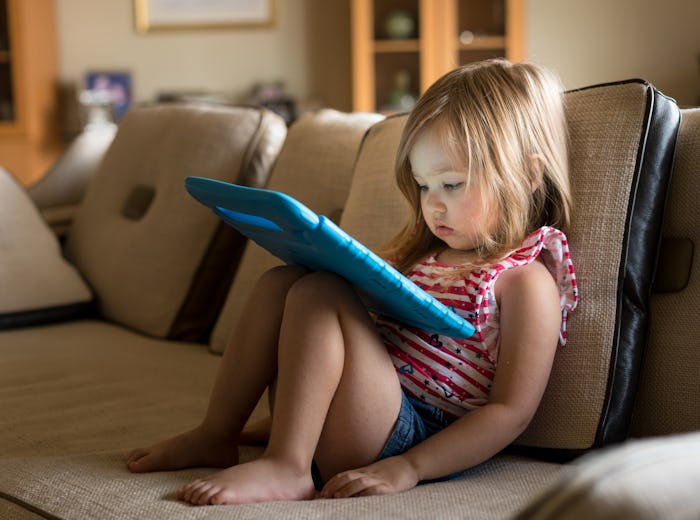Life
Here's What Could Actually Be Messing Up Your Kid's Bedtime Routine, According To Science
Sometimes, getting kids to go to bed can be a real chore. Even the most seasoned of parents can have trouble getting their children to actually get ready for bed and go to sleep, and it's not for lack of trying. But a new study shows that one factor can make a real difference when it comes to helping your kid get some sleep — bright light. Being exposed to bright light can affect kids' sleep, according to new research, and here's what parents should know about it to help their own kids get ready for bedtime.
Just one hour of exposure to bright light before bed almost totally shuts down the production of the sleep-promoting hormone melatonin in preschoolers, reported Perth Now/The Sunday Times after the study came out. Melatonin is a hormone that actually helps regulate your "sleep and wake cycles," not just promote sleep, according to WebMD. And messing with it at all can really wreak havoc on your sleep schedule.
Researchers wanted to take a look at the "dynamics" of the "light‐induced melatonin suppression response" in children, because it's been fairly well characterized in adults already, according to an article on the study published this week in the journal Physiological Reports. Specifically, researchers wanted to study melatonin suppression in preschool‐aged children, and their findings should definitely interest parents everywhere who have struggled with bedtime routines.
The researchers reportedly conducted an experiment in which they measured levels of melatonin in a group of 10 kids aged 3 to 5, The New York Times reported. Initially, they had the kids follow a regular sleep schedule for five days, all while checking their saliva several times a day to measure baseline levels of melatonin.
But on the sixth day, they turned the children’s homes into what the Times described as low-light “caves" — they covered windows with black plastic, and switched the light bulbs for low-wattage bulbs. This was in an attempt to be sure that the children involved were exposed to the same levels of light before new samples were taken, Boulder, Colorado's Patch affiliate reported. The kids spent the whole day in that dim lighting setting, and then the bright light exposure experiment began.
On day seven, the Physiological Reports article reported, "subjects remained in dim light conditions until 1‐h before bedtime, at which time they were exposed to a bright light stimulus." The researchers had the preschoolers play with a “light table” — a glass-topped surface that contained a bright light source — for an hour, and found that the exposure had a definite impact on the melatonin levels of the preschoolers.
Researchers played with subjects at the light table to make sure their gazes were actually looking down toward the light source, according to the Physiological Reports article. The kids colored on clear sheets and played with "open magnetic tiles" to ensure maximum light exposure for the subjects. Basically, the researchers did all they could to be sure it was actually the bright light exposure affecting the kids' melatonin levels.
And what they found isn't exactly a surprise, but it's certainly not great news. Lameese D. Akacem, an instructor at the University of Colorado, Boulder, and the lead author on the study, told The New York Times:
We found that the bright light exposure suppressed melatonin by almost 90 percent, and the effects persisted even after the kids returned to dim light.
And those melatonin levels stayed low for almost an hour after the exposure, FOX 47 reported. No wonder it sometimes seems to take forever to get an active preschooler to get sleepy and want to go to bed.
Keep in mind, the study sample size was very small, and it used only one intensity of light — 1,000 lux — according to Science Daily, which is "greater than the intensity of a typical handheld electronic device," Dr. Akacem noted.
But we already know that light can impact how much melatonin an adult body produces, according to WebMD — and in fact, during the shorter days of winter, your body might produce melatonin "either earlier or later in the day than usual" naturally. It's not exactly shocking that light can also impact the melatonin levels in very small children, but, "to our knowledge," according to the Physiological Reports article, "this study is the first to quantify the melatonin suppression response to evening light exposure in healthy 3‐ to 5‐year‐old children."
So what can parents do with this information? Senior study author Monique LeBourgeois, an associate professor in the Department of Integrative Physiology at CU-Boulder, told Science Daily:
The preschool years are a very sensitive time of development during which use of digital media is growing more and more pervasive.
We hope this research can help parents and clinicians make informed decisions on children's light exposure.
Essentially, parents should consider this information, and think about dimming the lights in the hours before bedtime. And limiting their exposure to handheld devices and digital media on other screens with bright light is probably not a bad idea. Maybe try to add in reading a good, old-fashioned, regular book to your kids to their routine at bedtime. It can't hurt, and Goodnight Moon is a classic that shouldn't be missed.
Check out Romper's new video series, Bearing The Motherload, where disagreeing parents from different sides of an issue sit down with a mediator and talk about how to support (and not judge) each other’s parenting perspectives. New episodes air Mondays on Facebook.
